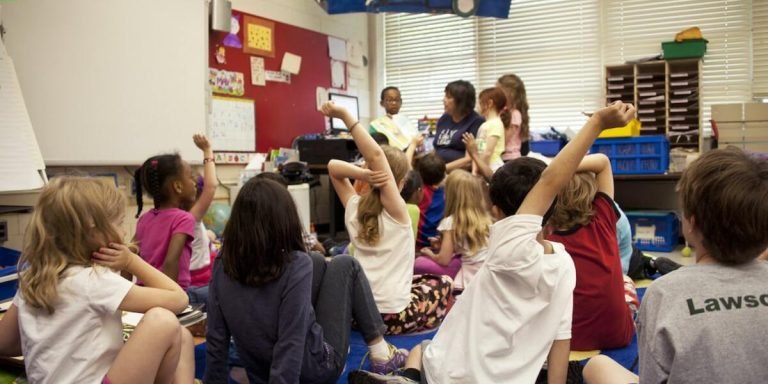AI for Teachers: Transforming Classroom Learning with Technology
The advent of artificial intelligence (AI) in education has marked a significant transformation, specifically offering an array of advantages for teachers. The concept of AI for teachers not only promotes efficiency but also introduces innovative methods to make learning more compelling and personalized.
From streamlining administrative tasks to enabling tailored educational content, AI technology is transforming the way educators teach and students learn. This groundbreaking shift could change classroom dynamics forever, creating an enhanced environment that fosters better understanding and interaction among pupils while supporting educators in their instructional roles.
Did you know?
A study by eSchoolNews found that 9 out of 10 educators are keen to use AI in their classrooms, yet only half feel they have the necessary tools and knowledge. This indicates a significant gap and potential for AI adoption in education.
Understanding the Role of AI in Teacher Support
The landscape of childhood education is constantly evolving, and in recent years the introduction of artificial intelligence (AI) has marked a significant shift. For parents and educators alike, understanding this innovative technology’s role can offer considerable support in navigating educational challenges more effectively.
AI isn’t about replacing teachers but rather aiding them by relieving some burdensome administrative tasks off their shoulders such as grading papers or creating reports. This allows for more time to be dedicated towards personal interactions with students – something that AI simply cannot replicate. Moreover, AI-driven platforms provide personalized learning environments tailored to each child’s individual needs making it easier for teachers to identify strengths and areas requiring improvement.
Furthermore, familiarizing oneself with how AI operates within an educational setting encourages informed discussions between parents and teachers regarding children’s progress and potential hurdles they may face during their developmental journey. Thus both parties-educators utilizing new technologies optimally while providing reassurance to anxious parents becomes possible when we embrace the ongoing advancements like Artificial Intelligence in teacher support.
How Artificial Intelligence Enhances Teaching Methodologies
Implementing AI for teachers isn’t just about the future, it’s happening right now. In classrooms worldwide, artificial intelligence is being leveraged to transform teaching methodologies and provide optimal support for educators.
AI offers a unique approach to education by adapting itself according to individual learning styles and patterns of students. It can recognize if a student learns better through visual aids or textual explanation and customize its educational material accordingly. This allows teachers to benefit from personalized instruction strategies without bearing the burden of creating them manually.
In addition, AI also enhances teaching methodologies by providing data-driven insights into student performance. Using such tools as predictive analysis algorithms, they present real-time progress reports on each pupil in an easy-to-understand format—making classroom monitoring more streamlined than ever before.
A key facet where AI assists is grading assignments—an arduous task that takes up hours of teacher’s times every week; but with automation stepping in this manual process becomes not only faster but also significantly more unbiased! Artificial Intelligence doesn’t experience fatigue or subjectivity which ensures accurate results consistently over time!
Moreover, using ai for teachers supports lesson planning too; integrating new methods seamlessly into existing curriculum models based on analysis conducted around successful lessons delivered in the past across different regions globally saving precious prep-hours while ensuring quality education delivery across all levels – primary schoolers through university attendees alike!
AI-Driven Analytics for Tailored Student Learning Plans
Artificial Intelligence (AI) has opened immense opportunities for teachers in terms of creating personalized lesson plans. Having “ai for teachers” means having a smart tool that can drive analytics and focus on individual learning capabilities.
Not all students absorb knowledge at the same pace or through the same methods, which is why tailored student learning plans are so vital. AI-driven educational platforms analyze each learner’s data to map out their unique patterns of understanding and engagement with various subjects.
For instance, some pupils excel when presented with visual content, while others prefer auditory cues. Some may need repeated practice to grasp templates completely; others understand concepts faster but need challenges to maintain their interest level. An intelligent system recognizes these differences amongst learners.
Besides this differentiation approach, integrating AI within classrooms also assists in tracking progress over time objectively rather than subjective teacher judgments alone. It’s equivalent to having an additional support system charting down every single step students take during their learning journey – every correct answer they provide, any struggle they face,and all achievements along the way.
Integrating AI Tools into Classroom Management
The integration of Artificial Intelligence (AI) into classroom management is a promising development in the education sector. As teachers continue seeking innovative methods to simplify their tasks and provide enriched learning experiences, AI stands out as an excellent resource. Incorporating AI tools not only optimizes classroom activities but also supports teacher’s efforts by offering personalized insights about each learner.
With evolving technology reshaping the teaching landscape, many educators are now turning towards intelligent systems for assistance. These advanced systems can automate administrative duties like grading assignments or monitoring student behavior, allowing teachers more time to focus on lesson planning and individual student attention.
Additionally, AI-powered tools can interpret complex data patterns to understand learners’ habits better—their strengths, weaknesses, preferred learning styles—and tailor instruction accordingly. Henceforth reinforcing inclusivity within classrooms as every child gets tutored based on their unique capabilities rather than a standardized curriculum approach.
Ultimately all these advancements made possible through ‘ai for teachers,’ aim at easing educational processes while enhancing students’ overall academic performance—providing parents peace of mind knowing that no matter what their child’s needs may be; there existed adequate support facilitated by modern-day technological wonders.
Automating Administrative Tasks to Maximize Instruction Time
In this rapidly evolving digital age, AI for teachers has become a critical asset in classroom management. A key area that it significantly impacts is the automation of administrative tasks which can greatly maximize instruction time.
Consider taking attendance – traditionally time-consuming and sometimes problematic. However, with artificial intelligence’s help, this process becomes quick and seamless by using facial recognition or engaging apps where students self-report their presence digitally.
Many educational institutions have also introduced virtual assistants powered by AI to handle questions from parents regarding class schedules, exam dates or school events . This not only eliminates human errors but frees up substantial amounts of administrators’ valuable working hours- making them available for higher-value responsibilities.
So how does all these impact teaching? With less burdensome paperwork on hand, educators gain back precious instructional periods otherwise lost battling administrative hassles; simultaneously improving learning outcomes as well as parent & educator support experiences overall!
Importantly though let’s remember that while integrating ai-tools may offer numerous benefits; they cannot replace the warmth and personal touch an engaged teacher provides.
Therefore even as we leverage technologies to enhance efficiency , staying mindful about keeping interactions personalised will ensure youngsters are nurtured into becoming confident learners prepared to face future challenges valiantly!
Real-Time Behavior Monitoring and Intervention Strategies
AI tools have proven to be revolutionary in the field of education, particularly when it comes to behavior monitoring and intervention. They’re not just for high-tech companies anymore; they can also offer significant advantages “ai for teachers”. Implementing AI into classroom management strategy offers real-time insight into students’ behaviors.
One primary way that ai is shaping up as a game-changer is through real-time behavior monitoring. Utilizing specific algorithms designed to understand and recognize patterns, these applications provide immediate feedback on student activity within digital learning platforms during class hours or homework sessions at home. This constant supervision ensures that inappropriate actions are immediately noticed and rectified before escalating further.
However, such innovative technology has more than one use- case scenario – beyond mere surveillance: It equips educators with precise data about each child’s educational progress habits and social interactions helping them tailor individual teaching methods accordingly.
The second aspect where AI makes its mark known loud & clear? Intervention strategies! Traditional discipline systems often fail because they don’t address causes behind misbehavior but merely punish consequences thereof – which rarely proves effective long-term solution pave ‘misbehaving’ kids better path towards growth fulfillment themselves society around.
Thankfully AI changes all this: By comprehending why bad conduct occurs using insightful analytics derived from detailed behavioural reports (created by same software earlier), artificial intelligence allows systematic implementation preventive measures help avoid disruptions altogether– transforming disciplinary procedure holistic health-supporting endeavor instead punitive exercise!
Professional Development Through AI Platforms
The rising influence of Artificial Intelligence (AI) in the field of education is undeniable. For educators, employing AI-powered platforms for professional development may seem like a leap into uncharted territory. However, as we grapple with an ever-evolving educational landscape and constantly changing learning needs in 2023, it has become imperative that teachers update their skillsets accordingly.
There’s no denying how technology has permeated every aspect of our lives today – including the classroom setting. As such, AI offers innovative tools to aid teachers not just in curriculum planning but also helps enrich teaching methodologies making them more effective and interactive than before. Whether it’s using predictive analytics to tailor instruction or utilizing smart content for differentiated learning experiences; these intelligent systems are enhancing pedagogical practices significantly.
AI platforms help bridge gaps by providing individualised resources aimed at strengthening weak areas while further developing strengths thereby achieving holistic teacher improvement goals effectively and efficiently.
Personalized Learning Paths for Educator Skill Enhancement
Embracing the advancements in technology is no longer an option but a necessity. The use of artificial intelligence (AI) for teachers has made notable strides, especially regarding professional development and enhancing educator skills. One such avenue AI has pioneered into is creating personalized learning paths.
Personalized Learning Paths are custom-made educational courses or materials tailored to cater to individual educators’ unique growth needs. They’re designed keeping mind that every teacher’s knowledge base, experience level, and skill set varies from one another – hence making ‘one size fits all’ approach ineffective in this modern era.
The abundance of data available on digital platforms allows AI systems to analyze each user’s strengths and weaknesses holistically. Based on these insights, it designs course content aimed at working upon areas needing improvement while further reinforcing areas where the educator excels.
Moreover, unlike traditional modes of teaching enhancement programs which operate strictly within fixed timelines regardless of pace or comfort ability levels; AI prioritizes flexibility over rigidity with its adaptive learning feature offering pathways tailor-suited not just according to capabilities but also availability schedule-wise – thus respecting work-life balance aspects as well!
Collaborative Networks Powered by Intelligent Systems
Collaborative networks have become an essential part of professional development in various fields, and it’s no different within the realm of childhood education. For instance, they can offer online forums where educators from across the world can exchange ideas about best practices or innovative strategies.
These platforms leverage AI technology to enhance user experience significantly. The built-in intelligence system manages massive amounts of data elegantly while providing personalized content based on individual needs—a feature that refines information overflows into more manageable streams.
For example, AI could analyze a history teacher’s browsing patterns and suggest resources related to imminent historical anniversaries or even local culture- this kind of tailored assistance directly benefits both student learning experiences and teachers’ professional growth.
Moreover, these smart platforms often come with chatbot features—conversational agents designed as artificial humans responding instantly—at any hour—to queries regarding technical issues or platform functionalities. This 24/7 support further empowers parents and educators alike who strive towards bettering children’s educational journey amidst their busy schedules.
Conclusion
With the advent of “AI for teachers,” classrooms are becoming vibrant hubs of technology-enhanced learning, paving a new path in childhood education. By embracing this shift and integrating Artificial Intelligence tools into their teaching methods, educators can provide personalized attention to each child while also enhancing their own effectiveness.
Don’t let the digital revolution pass you by! Start exploring our website today where there’s an immense reservoir of information on innovative methodologies like AI for educating children. You’ll find plenty of resources dedicated to both parents and educators alike, aimed at offering support during this exciting educational journey.
Remember – it’s always wise to stay ahead in knowledge when shaping young minds towards a brighter future!







